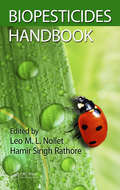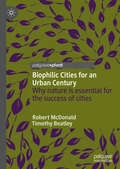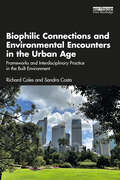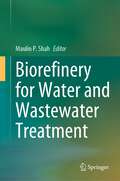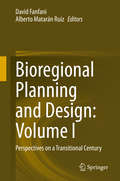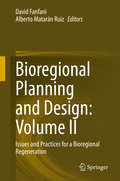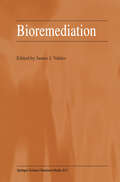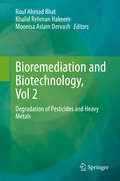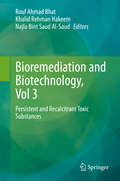- Table View
- List View
Bioorganic Marine Chemistry (Bioorganic Marine Chemistry #2)
by J. C. Coll G. B. Elyakov R. J. Quinn P. W. Sammarco V. A. Stonik K. TachibanaBurgeoning research into marine natural products during the past two decades has in no small measure been due to an heightened and world-wide interest in the ocean, to the development of new sophisticated computer-driven instrumentation, and to major advances in separation science. Organic chemists have been fully aware that processes in living systems occur in an aqueous medium. Nevertheless, the chemists who have specialized in the study of small molecules have found it expedient to use organic rather than aqueous solvents for the isolation and manipulation of secondary metabolites. The emergence of new chromatographic techniques, the promise of rewarding results, not to mention the relevance of polar molecules to life itself, have contributed to a new awareness of the importance of organic chemistry in an aqueous medium. The first chapter in Volume 2 of Bioorganic Marine Chemistry reflects the growing interest and concern with water-soluble com pounds. Quinn, who pioneered the separation of such molecules, has contributed a review which closely links techniques with results and is based on practical experience. The second chapter, by Stonik and Elyakov, examines the vast chemical literature of the phylum Echinodermata - over one fourth of it in difficulty accessible Russian language publications. The Soviet authors evaluate the data for their suitability as chemotaxonomic markers.
Bioorganic Marine Chemistry (Bioorganic Marine Chemistry #3)
by A. R. Davis M. P. Foster C. M. Ireland J. Kobayashi M. Kobayashi O. J. McConnell T. C. McKee T. F. Molinski D. J. Newman Y. Ohizumi D. M. Roll K. Sakata K. Snader M. Suffness N. Suzuki J. C. Swersey N. M. Targett C. M. Young T. M. ZabriskieThe first three chapters of Vol. 3 of Bio-organic Marine Chemistry deal with the chemistry and function of peptides. Chapter 1 by Ireland and coworkers serves as an introduction to marine-derived peptides. It is arranged phyletically and encompasses the entire range from dipeptides to a compound with 95 amino acid residues. Peptides involved in primary metabolism and hence belonging to the realm of macromolecular biochemistry are excluded. However, it might be mentioned in passing that the dividing line between large and small molecule chemistry is continually becoming less distinct. Not only are more compounds of intermediate size, from 1,000 to 10,000 dalton, being discovered, but instruments and techniques, particularly in mass spectrometry and nuclear magnetic resonance have been developed for their structural elucidation by what is considered small molecule methodology. Two groups of peptides are discussed in separate chapters. Biologists who have observed and described the mating behavior of diverse species of marine invertebrates have long surmised that a chemical mechanism might be operating in many cases of individual as well as mass fertilization. The chemical activators of sea urchin sperm prove to be a series of peptides, whose structures and activity are discussed by Suzuki.
Biopesticides Handbook
by Leo M. L. Nollet Hamir Singh RathoreThe need to feed an ever-growing global population combined with increasing demand for sustainable agricultural practices has generated a significant rise in demand for biopesticides. By responding concurrently to the interests of farming, forestry, and industrial sectors, biopesticides offer a considerable potential for utilization in sustainable
Biopesticides Handbook
by Leo M. L. Nollet Hamir Singh RathoreThe need to feed an ever-growing global population combined with increasing demand for sustainable agricultural practices has generated a significant rise in demand for biopesticides. By responding concurrently to the interests of farming, forestry, and industrial sectors, biopesticides offer a considerable potential for utilization in sustainable
Biophilic Cities for an Urban Century: Why nature is essential for the success of cities
by Robert McDonald Timothy BeatleyThis book argues that, paradoxically, at their moment of triumph and fastest growth, cities need nature more than ever. Only if our urban world is full of biophilic cities will the coming urban century truly succeed. Cities are quintessentially human, the perfect forum for interaction, and we are entering what could justly be called the urban century, the fastest period of urban growth in human history. Yet a growing body of scientific literature shows that the constant interaction, the hyper-connectedness, of cities leads to an urban psychological penalty. Nature in cities can be solution to this dilemma, allowing us to have all the benefits of our urban, connected world yet also have that urban home be a place where humanity can thrive. This book presents best practices and case studies from biophilic design, showing how cities around the world are beginning to incorporate nature into their urban fabric. It will be a valuable resource for scholars and professionals working in the area of sustainable cities.
Biophilic Connections and Environmental Encounters in the Urban Age: Frameworks and Interdisciplinary Practice in the Built Environment
by Richard Coles Sandra CostaBiophilic Connections and Environmental Encounters in the Urban Age takes a multi-disciplinary approach, drawing on the authors’ wide range of experience, to provide a greater understanding of the different dimensions of environmental engagement. It considers the ways that we interact with our environments, presenting a comprehensive account of how people negotiate and use the urban landscape. Set within current debates concerning urban futures, societal issues, sustainable cities, health and well-being, the book explores our innate need for contact with the natural world through biophilic design thinking to expand our knowledge base and promote a wider understanding of the importance of these interactions on our collective well-being. It responds to questions such as, what are the urban qualities that support our well-being? As an urbanised society what are the environmental determinants that promote healthy and satisfying lifestyles? Beginning with an overview of concepts relating to biophilia and environmental engagement, it moves through current theory and practice, different pathways and their characteristics, before presenting real world examples and applications through illustrated case studies in different world situations. With a particular focus on the experience of individuals, the book is essential reading for students, researchers, and practitioners of architecture, landscape architecture, urban planning, design and health sciences, interested in the future of our cities and the importance of green spaces.
Biophilic Connections and Environmental Encounters in the Urban Age: Frameworks and Interdisciplinary Practice in the Built Environment
by Richard Coles Sandra CostaBiophilic Connections and Environmental Encounters in the Urban Age takes a multi-disciplinary approach, drawing on the authors’ wide range of experience, to provide a greater understanding of the different dimensions of environmental engagement. It considers the ways that we interact with our environments, presenting a comprehensive account of how people negotiate and use the urban landscape. Set within current debates concerning urban futures, societal issues, sustainable cities, health and well-being, the book explores our innate need for contact with the natural world through biophilic design thinking to expand our knowledge base and promote a wider understanding of the importance of these interactions on our collective well-being. It responds to questions such as, what are the urban qualities that support our well-being? As an urbanised society what are the environmental determinants that promote healthy and satisfying lifestyles? Beginning with an overview of concepts relating to biophilia and environmental engagement, it moves through current theory and practice, different pathways and their characteristics, before presenting real world examples and applications through illustrated case studies in different world situations. With a particular focus on the experience of individuals, the book is essential reading for students, researchers, and practitioners of architecture, landscape architecture, urban planning, design and health sciences, interested in the future of our cities and the importance of green spaces.
A Biophilic Pattern Language for Cities: Creating Healthy Urban Environments (Sustainable Urban Futures)
by Phillip B. RoӧsThis book presents a holistic integral sustainable design and planning method embedded in the hypothesis of biophilia, our innate connection to nature, used as a platform to chart a biophilic pattern language framework. In A Biophilic Pattern Language for Cities, the author positioned the innate human-nature connection as critical in biophilic design and sustainable city planning solutions.
Biophilic Urbanism: Designing Resilient Communities for the Future
by Phillip James TabbBiophilic Urbanism provides readers with the tools to create more nature-based urban environments that are climate positive, sustainable, and healthy. The principles of biophilia are intended to support appreciation and direct engagement with nature, to responsibly utilize on-site natural resources, and to plan according to climatic conditions and local ecological processes. It seeks to create resilient and equitable human places capable of providing critical life-support functions and a strong sense of community, and to foster experiences that raise the human spirit creating a sense of awe. Twenty-five pattern attributes are defined and explored, each of which contributes to these goals. Because of the dire necessity to respond to the COVID-19 pandemic, Biophilic Urbanism includes discussion of our need for connections, both to nature and one another, and the physical characteristics of cities and buildings relative to the contagious qualities of the air-borne virus. Case studies, found throughout the world, are presented illustrating detailed biophilic planning and design strategies. The book will be of use to practitioners and students in the fields of natural and social sciences, behavioral science and psychology, environmental engineering, health and wellness professionals, architecture, landscape architecture, interior architecture, and planning.
Biophilic Urbanism: Designing Resilient Communities for the Future
by Phillip James TabbBiophilic Urbanism provides readers with the tools to create more nature-based urban environments that are climate positive, sustainable, and healthy. The principles of biophilia are intended to support appreciation and direct engagement with nature, to responsibly utilize on-site natural resources, and to plan according to climatic conditions and local ecological processes. It seeks to create resilient and equitable human places capable of providing critical life-support functions and a strong sense of community, and to foster experiences that raise the human spirit creating a sense of awe. Twenty-five pattern attributes are defined and explored, each of which contributes to these goals. Because of the dire necessity to respond to the COVID-19 pandemic, Biophilic Urbanism includes discussion of our need for connections, both to nature and one another, and the physical characteristics of cities and buildings relative to the contagious qualities of the air-borne virus. Case studies, found throughout the world, are presented illustrating detailed biophilic planning and design strategies. The book will be of use to practitioners and students in the fields of natural and social sciences, behavioral science and psychology, environmental engineering, health and wellness professionals, architecture, landscape architecture, interior architecture, and planning.
Biophysical and Biochemical Characterization and Plant Species Studies
by Prasad S. Thenkabail John G. Lyon Alfredo HueteWritten by leading global experts, including pioneers in the field, the four-volume set on Hyperspectral Remote Sensing of Vegetation, Second Edition, reviews existing stateof- the-art knowledge, highlights advances made in different areas, and provides guidance for the appropriate use of hyperspectral data in the study and management of agricultural crops and natural vegetation. Hyperspectral remote sensing or imaging spectroscopy data has been increasingly used in studying and assessing the biophysical and biochemical properties of agricultural crops and natural vegetation. Volume III, Biophysical and Biochemical Characterization and Plant Species Studies demonstrates the methods that are developed and used to study terrestrial vegetation using hyperspectral data. This volume includes extensive discussions on hyperspectral data processing and how to implement data processing mechanisms for specific biophysical and biochemical applications such as crop yield modeling, crop biophysical and biochemical property characterization, and crop moisture assessments. The concluding chapter provides readers with useful guidance on the highlights and essence of Volume III through the editors’ perspective. Key Features of Volume III: Covers recent abilities to better quantify, model, and map plant biophysical, biochemical water, and structural properties. Demonstrates characteristic hyperspectral properties through plant diagnostics or throughput phenotyping of plant biophysical, biochemical, water, and structural properties. Establishes plant traits through hyperspectral imaging spectroscopy data as well as its integration with other data, such as LiDAR, using data from various platforms (ground-based, UAVs, and earth-observing satellites). Studies photosynthetic efficiency and plant health and stress through hyperspectral narrowband vegetation indices. Uses hyperspectral data to discriminate plant species and\or their types as well as their characteristics, such as growth stages. Compares studies of plant species of agriculture, forests, and other land use\land cover as established by hyperspectral narrowband data versus multispectral broadband data. Discusses complete solutions from methods to applications, inventory, and modeling considering various platform (e.g., earth-observing satellites, UAVs, handheld spectroradiometers) from where the data is gathered. Dwells on specific applications to detect and map invasive species by using hyperspectral data.
Biopolymers: A molecular paleontology approach (Topics in Geobiology #38)
by Neal S. GuptaThis book provides an overview, research compendium and an introduction to the science of molecular paleontology, including literature overview for non-geochemists. Analytical methods employed are included as a part of each chapter that underpin this branch of paleontology and indeed geochemistry. The primary usefulness of this volume is for organic geochemists, molecular palaeontologists, and molecular archeologists. Researchers, graduate students and academics interested in astrobiology from a paleontological perspective may also find this to be valuable.
Bioprospects of Coastal Eubacteria: Ecosystems of Goa
by Sunita BorkarThis book is a collection of scholarly articles presenting the research results of work carried out under the supervision of Prof. Saroj Bhosle, a microbiologist at Goa University, India.The objective of this volume is to document the comprehensive ecological knowledge of eubacteria isolated from diverse coastal ecosystems of Goa, little explored for microbiological studies. These ecosystems need to be properly tapped in order to reveal potential bacteria yet to be exploited. The topics of this book are particularly relevant to researchers and students in the field of microbiology with an interest in the varied aspects of eubacteria. They provide academic insight for scientific communities in Goa and the rest of the world.
Biorefinery for Water and Wastewater Treatment
by Maulin P. ShahBio-refinery approach of microbial fermentation, production of biogas, bioenergy, enzymes, bioactive molecules, agricultural nutrient and many more, which is presently restricted to specific journals, review articles and research papers in conference proceedings. Hence, my effort is to provide a complete and globally available advance knowledge in wastewater treatment with an aim of recovery of value added products. This will help in designing new approaches of waste water treatment with this value added thoughts. Thus, it will be a boon for a concern broad range of readers and industry professionals to their means of technology development for pollution prevention and economic growth of the country.
The Bioregional Economy: Land, Liberty and the Pursuit of Happiness
by Molly Scott CatoIn a world of climate change and declining oil supplies, what is the plan for the provisioning of resources? Green economists suggest a need to replace the globalised economy, and its extended supply chains, with a more ‘local’ economy. But what does this mean in more concrete terms? How large is a local economy, how self-reliant can it be, and what resources will still need to be imported? The concept of the ‘bioregion’ — developed and popularised within the disciplines of earth sciences, biosciences and planning — may facilitate the reconceptualisation of the global economy as a system of largely self-sufficient local economies. A bioregional approach to economics assumes a different system of values to that which dominates neoclassical economics. The global economy is driven by growth, and the consumption ethic that matches this is one of expansion in range and quantity. Goods are defined as scarce, and access to them is a process based on competition. The bioregional approach challenges every aspect of that value system. It seeks a new ethic of consumption that prioritises locality, accountability and conviviality in the place of expansion and profit; it proposes a shift in the focus of the economy away from profits and towards provisioning; and it assumes a radical reorientation of work from employment towards livelihood. This book by leading green economist Molly Scott Cato sets out a visionary and yet rigorous account of what a bioregional approach to the economy would mean — and how to get there from here.
The Bioregional Economy: Land, Liberty and the Pursuit of Happiness
by Molly Scott CatoIn a world of climate change and declining oil supplies, what is the plan for the provisioning of resources? Green economists suggest a need to replace the globalised economy, and its extended supply chains, with a more ‘local’ economy. But what does this mean in more concrete terms? How large is a local economy, how self-reliant can it be, and what resources will still need to be imported? The concept of the ‘bioregion’ — developed and popularised within the disciplines of earth sciences, biosciences and planning — may facilitate the reconceptualisation of the global economy as a system of largely self-sufficient local economies. A bioregional approach to economics assumes a different system of values to that which dominates neoclassical economics. The global economy is driven by growth, and the consumption ethic that matches this is one of expansion in range and quantity. Goods are defined as scarce, and access to them is a process based on competition. The bioregional approach challenges every aspect of that value system. It seeks a new ethic of consumption that prioritises locality, accountability and conviviality in the place of expansion and profit; it proposes a shift in the focus of the economy away from profits and towards provisioning; and it assumes a radical reorientation of work from employment towards livelihood. This book by leading green economist Molly Scott Cato sets out a visionary and yet rigorous account of what a bioregional approach to the economy would mean — and how to get there from here.
Bioregional Planning and Design: Perspectives on a Transitional Century
by David Fanfani Alberto Matarán RuizThis book provides a review of the bioregionalist theory in the field of spatial planning and design as a suitable approach to cope with the growing concerns about the negative effects of metropolization processes and the need for a sustainable transition. The book starts out with a section on rethinking places for community life, and discusses the reframing of regional governance and development as well as social justice in spatial planning. It introduces the concept of the urban bioregion, a pivotal concept that underpins balanced polycentric spatial patterns and supports self-reliant and fair local development. The second part of the book focuses on planning, and particularly on the issues that arise from the ‘circular’ recovery of the relation between city and agro-ecosystems for integrated planning and resilience of settlements and discusses topics such as foodshed planning, biophilic urbanism and the integration of rural development and spatial planning. This volume sets out the reference framework for Volume II which deals with more specific and operational issues related to spatial policies and settlement design.
Bioregional Planning and Design: Issues and Practices for a Bioregional Regeneration
by David Fanfani Alberto Matarán RuizThis book provides insights and discusses the practical application of the theoretical concept of urban bioregion complementing the general bio-regional planning cross-disciplinary issues provided in Volume I. It examines planning practices, such as relocalisation of energy flows, land protection for climate change, territorial heritage enhancement, the consideration of urban ecosystems and agro-ecology. It presents discussions on regional contexts, practices and projects for a bioregional recovery, and includes case studies from France, Belgium, Spain, Greece, Austria and Italy, discussing topics that range from the reframing of local energy production/delivery planning systems to soil protection and farmland sustainable exploitation schemes. This volume concludes with three cross-European case studies that make clear the worldwide relevance and potential of bioregional approach beyond the Global North or Western countries.
Bioregionalism
by Michael Vincent McGinnisBioregionalism is the first book to explain the theoretical and practical dimensions of bioregionalism from an interdisciplinary standpoint, focusing on the place of bioregional identity within global politics. Leading contributors from a broad range of disciplines introduce this exciting new concept as a framework for thinking about indigenous peoples, local knowledge, globalization, science, global environmental issues, modern society, conservation, history, education and restoration. Bioregionalism's emphasis on place and community radically changes the way we confront human and ecological issues.
Bioregionalism
by Michael Vincent McGinnisBioregionalism is the first book to explain the theoretical and practical dimensions of bioregionalism from an interdisciplinary standpoint, focusing on the place of bioregional identity within global politics. Leading contributors from a broad range of disciplines introduce this exciting new concept as a framework for thinking about indigenous peoples, local knowledge, globalization, science, global environmental issues, modern society, conservation, history, education and restoration. Bioregionalism's emphasis on place and community radically changes the way we confront human and ecological issues.
Bioremediation: A Sustainable Approach to Preserving Earth’s Water
by Sanjay K. SharmaBioremediation: A Sustainable Approach to Preserving Earth’s Water discusses the latest research in green chemistry practices and principles that are involved in water remediation and the quality improvement of water.The presence of heavy metals, dyes, fluoride, dissolved solids and many other pollutants are responsible for water pollution and poor water quality. The removal of these pollutants in water resources is necessary, yet challenging. Water preservation is of great importance globally and researchers are making significant progress in ensuring this precious commodity is safe and potable. This volume illustrates how bioremediation in particular is a promising green technique globally.Features: Addresses bioremediation of all the major water pollutants Approaches the chemistry of water and the concept of water as a renewable resource from a green chemistry aspect Discusses environmental chemistry and the practice of industrial ecology Explains the global concern of adequate high quality water supplies, and how bioremediation can resolve this Explores sustainable development through green engineering
Bioremediation: A Sustainable Approach to Preserving Earth’s Water
by Sanjay K. SharmaBioremediation: A Sustainable Approach to Preserving Earth’s Water discusses the latest research in green chemistry practices and principles that are involved in water remediation and the quality improvement of water.The presence of heavy metals, dyes, fluoride, dissolved solids and many other pollutants are responsible for water pollution and poor water quality. The removal of these pollutants in water resources is necessary, yet challenging. Water preservation is of great importance globally and researchers are making significant progress in ensuring this precious commodity is safe and potable. This volume illustrates how bioremediation in particular is a promising green technique globally.Features: Addresses bioremediation of all the major water pollutants Approaches the chemistry of water and the concept of water as a renewable resource from a green chemistry aspect Discusses environmental chemistry and the practice of industrial ecology Explains the global concern of adequate high quality water supplies, and how bioremediation can resolve this Explores sustainable development through green engineering
Bioremediation
by James J. ValdesIn the field of biosensors the previous focus has been almost entirely on medical diagnostics. Here it is discussed in relation to bioremediation. The application of new biosensing techniques to environmental monitoring promises to be a more economical approach to monitoring both soil consortia and levels of pollutants. Significantly, functional biosensors can determine such parameters as`How clean is clean?' This new edition is targeted specifically at graduate students and environmental professionals.
Bioremediation and Biotechnology, Vol 2: Degradation of Pesticides and Heavy Metals
by Rouf Ahmad Bhat Khalid Rehman Hakeem Moonisa Aslam DervashThis book addresses the grave concerns stemming out due to conventional treatment techniques. The main focus of this book revolves round the central kernel of novel technology (bioremediation and biotechnology) which has emerged as an independent warrior to clean up and restore the disturbed environs. Furthermore, this book is a coherent assortment of diverse chapters relevant to the role of biotechnology and bioremediation for restoration of the ecosystems degraded by pesticide and heavy metal pollution. The inaugural chapters deal with the quantification of problem and its magnitude due to pesticides and heavy metals, followed by innovative modern biotechnological and bioremediation treatment technologies and sustainable techniques to remediate the persistent pollutants. It is a detailed comprehensive account for the treatment technologies from unsustainable to sustainable. Academicians, researchers and students shall find it as a complete wrap up regarding biotechnological intervention for sustainable treatment of pollution and shall suffice for the diverse needs of teaching and research.
Bioremediation and Biotechnology, Vol 3: Persistent and Recalcitrant Toxic Substances
by Rouf Ahmad Bhat Khalid Rehman Hakeem Najla Bint Saud Al-SaudHealthy environment is important for any kind of biota on earth. It provides the basic elements of life such as clean water, fresh air, fertile soil and supports ecosystem of the food chain. Pollution drastically alters quality of the environment by changing the physico-chemical and biological aspects of these components. Accordingly, toxic metals, combustible and putrescible substances, hazardous wastes, explosives and petroleum products are all examples of inorganic and organic compounds that cause contaminations. Specifically, pollution of toxic and heavy metal in the environment is a growing problem worldwide, currently at an alarming rate. Toxic metals threaten the aquatic ecosystems, agriculture and ultimately human health. Traditional treatment techniques offer certain advantages such as rapid processing, ease of operation and control and flexibility. But, they could not maintain the quality of the environment due to the high operational costs of chemicals used, high energy consumption and handling costs for sludge disposal and overburden of chemical substances which irreversibly affect and destroy biodiversity, which ultimately render the soil useless as a medium for plant growth. Therefore, bioremediation and biotechnology, carried out by living assets to clean up, stabilize and restore contaminated ecosystems, have emerged as promising, environmental friendly and affordable approaches. Furthermore, the use of microbes, algae, transgenic plants and weeds adapted to stressful environments could be employed to enhance accumulation efficiency. Hence, sustainable and inexpensive processes are fast emerging as a viable alternative to conventional remediation methods, and will be most suitable for developing countries.In the current volume, we discuss pollution remediation challenges and how living organisms and the latest biotechnological techniques could be helpful in remediating the pollution in ecofriendly and sustainable ways.


